|
|

|
|
Author
|
Topic: Space Cover 401: Iven Kincheloe, Ace Test Pilot
|
stevedd841
Member Posts: 299
From: Millersville, Maryland
Registered: Jul 2004
|
 posted 01-22-2017 09:10 AM
posted 01-22-2017 09:10 AM
   
Space Cover of the Week, Week 401 (January 22, 2017)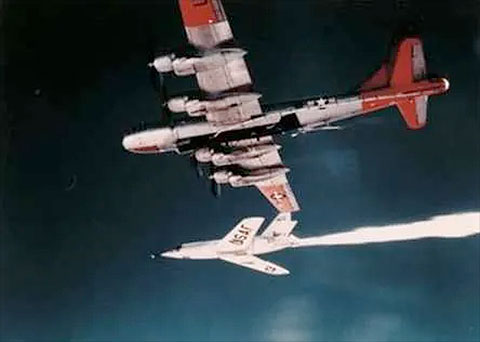 X-2 rocket plane is released by Boeing EB-50D Superfortress on its test flight over Edwards Air Force Base, California. Credit: USAFSpace Cover #401: Captain Iven Kincheloe, USAF Test Pilot As a newcomer assigned to the U.S. Air Force Flight Test Center, Edwards Air Force Base, California, Captain Iven Kincheloe could not fly the research aircraft he desired right away. Instead the new test pilot flew "chase" for the more experienced men in the experimental planes. The chase pilot flew alongside the test aircraft and watched for any external trouble which the pilot could not see. Kincheloe flew as many chase flights as he could get and finally was assigned to his first test project — checking the gunnery defects in a new supersonic fighter, the F-100. He did the job so well that he was given better assignments flying initial Air Force evaluation tests on such brand new jet fighters as the McDonnell F-101, Convair F-102, Lockheed F-104, and Republic F-105. These were the Phase II tests in which Air Force pilots put the new plane through its paces after a few demonstrations by the manufacturer.
One day, Kincheloe saw a remarkable new research plane — the Bell X-2. The rocket-powered plane was designed to investigate performance at speeds and altitudes never before achieved by man, and to explore the aerodynamic heating problems encountered at these speeds and altitudes. To do this task, the X-2 was built with sturdy steel wings and tail, and a K-Monel metal fuselage. Its rocket engine burned a mixture of liquid oxygen and alcohol, and the craft had to be launched by dropping it from a B-50 bomber in flight. The first X-2 had exploded over Lake Ontario, killing Bell's test pilot, Skip Ziegler. This was the second X-2 which now rested, quiet and docile, in the hanger at Edwards. Iven Kincheloe knew he had to fly it. Pete Everest was the test pilot on the X-2 project, and he chose Kincheloe to fly chase for him.
On its first flight, the X-2 was slightly damaged in landing, and the program was delayed. Kincheloe returned to more routine flying and was selected as project officer for the new F-100C which kept him busy into the spring of 1956. But he still had his heart set on flying the X-2. In April the X-2 program went into high gear when Pete Everest flew the rocket plane to sixty thousand feet at one thousand two hundred miles per hour. Then Everest received word that he might be transferred and recommended Kincheloe and another test pilot, Mel Apt, as his alternates. Meanwhile, he would continue to fly the X-2 while breaking in the new men. On May 22 Everest flew the X-2 at 1,650 miles per hour and earned the title of "the fastest man alive." Kincheloe made his first checkout flight in the X-2 on May 25, 1956. He was five inches taller than Everest and in his pressure suit and parachute, he had no room to spare in the tiny cockpit. "I just won't rattle around as much," he stated. The flight itself was not very spectacular. Its purpose was to give Kincheloe the feel of the airplane, not to set records. On July 23, 1956, Everest made his last flight in the X-2 and reached one thousand nine hundred miles per hour, almost three times the speed of sound. Then he left on another assignment, and at last the X-2 belonged to test pilot Iven Kincheloe.
His first goal was to reach an altitude of 100,000 feet or better, but first he had to feel out the plane's reactions at a slightly lower altitude. On August 3, 1956 Kincheloe climbed to an altitude of 87,750 feet at an air speed of one thousand seven hundred miles per hour with no control problems. The stage had now been set for Kincheloe's flight into the fringe of space. 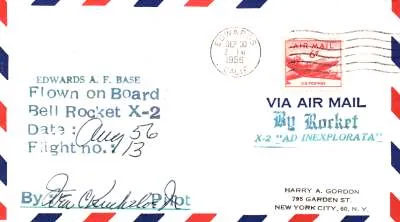 The cover above records a test flight in the Bell X-2 rocket plane by USAF test pilot Iven Kincheloe, made August 8, 1956, possibly for test flight 13. The cover was mailed by correspondent Harry Gordon to test pilot Kincheloe requesting that his flight cover be flown on an X-2 test flight by the pilot. His request was forwarded to Kincheloe by the Edwards AFB Commanding Officer back to Gordon stating that it might be possible. As requested, Kincheloe has signed the cover for his X-2 test flight and noted it as X-2 flight 13. 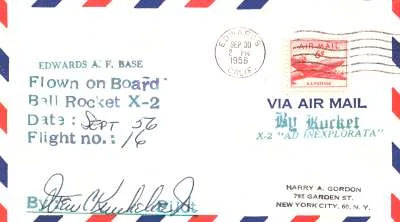 X-2 test flight cover 16 flown by Iven Kincheloe, September 7, 1956, at Edwards Air Force Base, California. The flight's altitude set an unofficial record of 126,000 feet, the highest altitude to date for the Bell X-2 rocket plane and a precursor of speed and altitude that were achieveable. Kincheloe has signed his flight cover and cited this X-2 test flight as flight 16 before mailing it back to Harry Gordon. 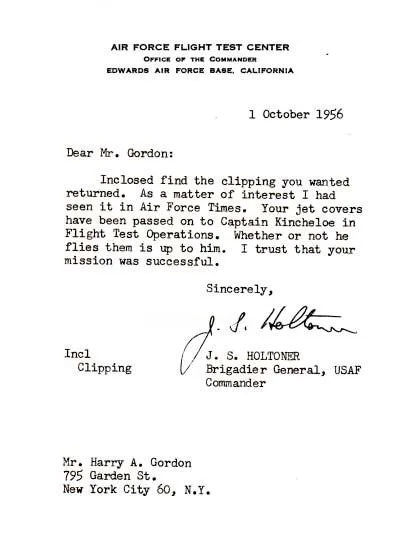 Letter from Air Force Flight Test Center Commanding Officer, BGEN J.S. Holtoner, to correspondent Harry Gordon, concerning Gordon's request for Iven Kincheloe to carry his covers on X-2 test flights he is flying at Flight Test Operations at Edwards Air Force Base, California. BGEN Holtoner responds, "Whether or not he flies them is up to him." Amazingly, he does fly them, signs them, and mails them back to Gordon. Slated to become the first test pilot to fly the X-15 rocket plane, and to achieve spaceflight, fate would tragically intervene. Captain Iven Kincheloe would be killed in a crash of his U.S. Air Force F-104 Starfighter on July 26, 1958, over Edwards Air Force Base. It was not to be. Steve Durst, SU 4379 |
Ken Havekotte
Member Posts: 3911
From: Merritt Island, Florida, Brevard
Registered: Mar 2001
|
 posted 01-22-2017 12:14 PM
posted 01-22-2017 12:14 PM
   
Nice tribute, Steve, to test pilot Iven Kincheloe and the X-2 rocket research program. During his tenure with the X-2 program, he was dubbed the "first of the spacemen" as reported by aerospace flight historian Richard Hallion of the NASA History Series. I think Capt. Kincheloe was the first rocketplane research pilot to experience weightless spaceflight, but correct me if I am wrong. Of all the X-plane programs throughout the 1950's, Steve, it seems the X-2 caused more frustration and disappointment than any other high speed/altitude flight test effort. While two aircraft were built and flight tested from 1954-56, both were destroyed with three fatalities. Do you know of any other flown X-2 covers besides those of Harry Gordon's collections? I never knew Gordon was a correspondent (whom did he work for?) and did he know and work with Barbara Baker in acquiring similar flown covers? If I am not mistaken, there may be a few other flown X-2 covers from Baker of the 17 glide and powered flights of the X-2. |
stevedd841
Member Posts: 299
From: Millersville, Maryland
Registered: Jul 2004
|
 posted 01-22-2017 06:48 PM
posted 01-22-2017 06:48 PM
   
quote:
Originally posted by Ken Havekotte:
Of all the X-plane programs throughout the 1950's, Steve, it seems the X-2 caused more frustration and disappointment than any other high speed/altitude flight test effort.
Ken, you are on target. The X-2 could have been the success story that North American's X-15 was. Three exceptional X-2 test pilots died showing the way for the X-15's introduction and success. quote:
I never knew Gordon was a correspondent (whom did he work for?) and did he know and work with Barbara Baker in acquiring similar flown covers?
I think there was a connection. It also is feasible that Barbara may have acquired some of Harry's better covers as she got further into flown space covers. She also corresponded with the test pilots and early astronauts on a personal level, almost unheard of today. |
micropooz
Member Posts: 1813
From: Washington, DC, USA
Registered: Apr 2003
|
 posted 01-23-2017 07:40 PM
posted 01-23-2017 07:40 PM
   
quote:
Originally posted by Ken Havekotte:
Do you know of any other flown X-2 covers besides those of Harry Gordon's collections?
In addition to Harry Gordon, there are also X-2 flown covers in existence addressed to Edmond C Browne and to J. Cronin, Jr. I've never seen any addressed to Barbara Baker - I believe she may have started her efforts after the X-2 program ended. And now on a slightly different subject: I hate to be a troll, but I am still not convinced that these September 30, 1956 postmarked covers, postmarked three days after the X-2 was destroyed, and one day before Gen. Holtoner's letter above, were flown on the X-2. Rationale is in SCOTW 385. But as mentioned above, anything autographed by Kincheloe is a rare piece of history that any collector should value. |
Ken Havekotte
Member Posts: 3911
From: Merritt Island, Florida, Brevard
Registered: Mar 2001
|
 posted 01-23-2017 09:08 PM
posted 01-23-2017 09:08 PM
   
Very good and well done, Dennis, as I had forgotten about your earlier posting from Sept. 2016. Your careful research on the X-2 "flown" covers addressed to Gordon may not be a simple issue or topic as first thought. First off, though, we can probably never be completely certain that generic rubber-stamp cachet covers produced like this, filled in and signed by the pilot(s), were indeed flown. In such instances as this, Dennis, if there is no pilot-notated or implied inscription that such a cover did in fact fly with him on a certain designated research flight (or even in a letter, on a card, etc.), I guess you can never really be certain of a "for sure" flown status. Regarding the X-2 flight history record, to the best of my knowledge and limited research efforts, I am seeing a total of 17 glide and powered flights from Aug. 3, 1954 to Sept. 27, 1956. The first glide flight of the X-2 was damaged on landing. Glide flights 2 and 3, flown by Everest, were flown in 1955. There was an aborted mission, set to be the first powered rocketplane flight in the Bell X-2 program, became the 4th glide flight. First powered flight, again by Everest, was on Nov. 18, 1955, but it wasn't designated as Flight 1. "Flight 1" in March 1956 was actually the 2nd powered flight, according to the official records of the air force flight test center. After "Flight 1," there were 11 more "Flight"-numbered test flights ending with Flight 12 on Sept. 27, 1956, which was the only X-2 flight piloted by Mel Apt, perhaps the most experienced pilot at Edwards on the phenomenon of inertial coupling. It was his first rocket-powered airplane flight that also took his life. It does seem that Kincheloe's X-2 flight numbering system, as indicated on Steve's depicted covers, is confusing and difficult to understand. |
stevedd841
Member Posts: 299
From: Millersville, Maryland
Registered: Jul 2004
|
 posted 01-24-2017 06:20 PM
posted 01-24-2017 06:20 PM
   
quote:
Originally posted by Ken Havekotte:
Do you know of any other flown X-2 covers besides those of Harry Gordon's collections?
Ken, this is a flown cover for the first X-2 flight by Frank Everest also from my collection. The cover was not owned by Harry Gordon but was owned by another early X-2 collector, a Mr. Raymond Davis, from Poughkeepsie, New York. 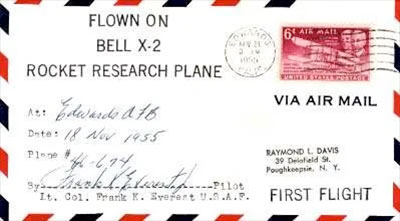 |
Bob M
Member Posts: 1972
From: Atlanta-area, GA USA
Registered: Aug 2000
|
 posted 01-28-2017 11:39 AM
posted 01-28-2017 11:39 AM
   
Very fascinating person (Kincheloe) and subject (X-2 rocket plane). Capt. Kincheloe was the chief X-15 test pilot and would have flown many X-15 flights, but was tragically killed in July 1958, at age 30, before the X-15 flights began. He was highly regarded and had he lived and flown the X-15, he, like Neil Armstrong, may have been selected as a NASA Astronaut and, perhaps been a lunar astronaut. It was not meant to be. | |
Contact Us | The Source for Space History & Artifacts
Copyright 1999-2024 collectSPACE. All rights reserved.

Ultimate Bulletin Board 5.47a
|
|

|
 advertisement advertisement

|
















